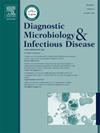细粒棘球绦虫诱导AML12肝细胞线粒体自噬和线粒体功能障碍
IF 1.8
4区 医学
Q3 INFECTIOUS DISEASES
Diagnostic microbiology and infectious disease
Pub Date : 2025-06-12
DOI:10.1016/j.diagmicrobio.2025.116952
引用次数: 0
摘要
囊性包虫病(CE)的发病机制尚不完全清楚。本研究旨在探讨颗粒棘球绦虫原头节蚴(E. granulosus PSCs)对AML12肝细胞线粒体功能和线粒体自噬途径的影响,为CE的发病机制提供新的思路。AML12肝细胞与50、100和200粒棘球绦虫psc共培养48小时。采用以下方法:分离颗粒棘球蚴PSCs, MTT法评估细胞活力,LDH释放法评估细胞毒性,测定氧化应激标志物(MDA水平、SOD活性和GSH水平),Rh123染色测定线粒体膜电位(MMP),细胞内ATP测定,线粒体呼吸速率检测,Real-time PCR分析基因表达,Western blotting分析。颗粒棘球绦虫PSCs感染显著降低细胞活力,并以剂量依赖性方式增加LDH释放。氧化应激明显,MDA水平升高,SOD活性降低,GSH水平降低。线粒体功能障碍表现为MMP和ATP水平降低,以及线粒体呼吸速率降低。此外,颗粒棘球线虫PSCs感染上调了线粒体自噬标志物(p62和LC3Ⅱ/Ⅰ)和线粒体自噬信号蛋白(PINK1和Parkin)的表达。值得注意的是,沉默PINK1减轻了颗粒棘球蚴PSCs诱导的AML12肝细胞的线粒体自噬激活。颗粒棘球蚴PSCs感染可诱导AML12肝细胞自噬和线粒体功能障碍。本文章由计算机程序翻译,如有差异,请以英文原文为准。
Echinococcus granulosus induces mitophagy and mitochondrial dysfunction in AML12 hepatocytes
The pathogenesis of Cystic echinococcosis (CE) remains incompletely understood. This study aimed to explore the effects of Echinococcus granulosus protoscoleces (E. granulosus PSCs)on mitochondrial function and mitophagy pathways in AML12 hepatocytes, providing insights into the pathogenesis of CE. AML12 hepatocytes were co-cultured with 50, 100, and 200 E. granulosus PSCs for 48 hours. The following methods were employed: isolation of E. granulosus PSCs , MTT assay for cell viability assessment, LDH release assay for cytotoxicity evaluation, measurement of oxidative stress markers (MDA levels, SOD activity, and GSH levels), Rh123 staining for mitochondrial membrane potential (MMP) determination, intracellular ATP measurement, mitochondrial respiratory rate detection, Real-time PCR for gene expression analysis, and Western blotting. E. granulosus PSCs infection significantly reduced cell viability and increased LDH release in a dose-dependent manner. Oxidative stress was evident, with elevated MDA levels, decreased SOD activity, and reduced GSH levels. Mitochondrial dysfunction was demonstrated by decreased MMP and ATP levels, as well as reduced mitochondrial respiration rates. Furthermore, E. granulosus PSCs infection upregulated the expression of mitophagy markers (p62 and LC3 Ⅱ/Ⅰ) and mitophagy signaling proteins (PINK1 and Parkin). Notably, silencing PINK1 mitigated the E. granulosus PSCs induced mitophagy activation in AML12 hepatocytes. E. granulosus PSCs infection induces mitophagy and mitochondrial dysfunction in AML12 hepatocytes.
求助全文
通过发布文献求助,成功后即可免费获取论文全文。
去求助
来源期刊
CiteScore
5.30
自引率
3.40%
发文量
149
审稿时长
56 days
期刊介绍:
Diagnostic Microbiology and Infectious Disease keeps you informed of the latest developments in clinical microbiology and the diagnosis and treatment of infectious diseases. Packed with rigorously peer-reviewed articles and studies in bacteriology, immunology, immunoserology, infectious diseases, mycology, parasitology, and virology, the journal examines new procedures, unusual cases, controversial issues, and important new literature. Diagnostic Microbiology and Infectious Disease distinguished independent editorial board, consisting of experts from many medical specialties, ensures you extensive and authoritative coverage.

 求助内容:
求助内容: 应助结果提醒方式:
应助结果提醒方式:


